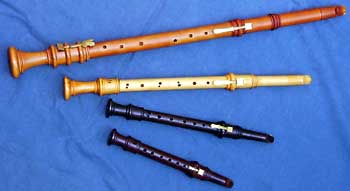Here's some information on the instrument I play now: the Bb (B-flat) clarinet.
 |
| A chalumeau |
The clarinet is derived from the chalumeau, a instrument from the Baroque era. Its creation was sparked when a single reed was added to the recorder in order to increase its volume. However, it still had a limited, low range. (Thus, the lowest section of the clarinet's range is still referred to as the "chalumeau".) The introduction of the "speaker key" began turning the chalumeau into the clarinet, and the "first clarinet" was built by Johann Christoph Denner of Nuremberg in 1700.
 |
The modern clarinet's register key is
similar to a chalumeau's speaker key |
The "modern" clarinet was developed by Hyacinthe Eléonore Klosé and L.-A. Buffet. It introduced keys that followed the Boehm key system (which was based on principles for the flute) and helped cover or uncover holes and change the pitch. It was a regular part of the symphony orchestra by the 19th century and the jazz band by the first part of the 20th century.
The clarinet's
compass is the largest of all common woodwind instruments, extending from D' to c'''' (for more information, see Helmholtz pitch notation). It is divided into four sections (chalumeau, throat tones, clarion, and altissimo), each of which has its own distinct sound.
 |
| The Bb clarinet's compass |



No comments:
Post a Comment